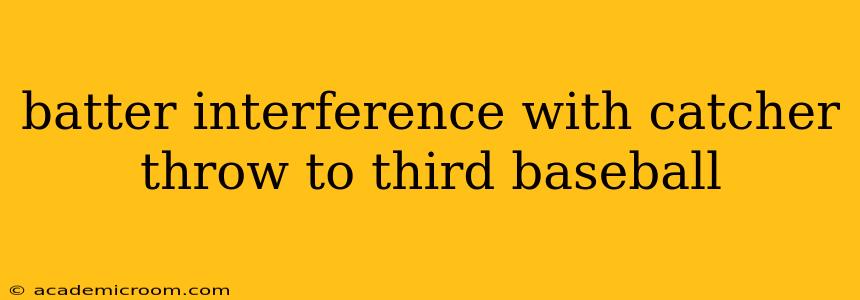Batter interference is a common rule in baseball that often leads to confusion, particularly when it involves a catcher's throw to third base. This comprehensive guide will clarify the rule, explore common scenarios, and answer frequently asked questions surrounding this specific situation. Understanding this rule is crucial for both players and fans alike to appreciate the nuances of the game.
What Constitutes Batter Interference?
Batter interference is called when a batter impedes the progress of a play, typically involving a batted ball or a throw. In the context of a catcher's throw to third, interference occurs when the batter, before the ball passes the catcher's mitt, obstructs the throw in any way. This includes, but isn't limited to:
- Swinging at a pitch: If a batter swings and misses a pitch, and that swing interferes with the catcher's throw to third, it's interference. The key here is that the interference must directly impact the play, not merely be incidental.
- Reaching out: If a batter reaches out to interfere with the throw, even without a swing, it's interference. This includes intentionally or unintentionally obstructing the line of the throw.
- Stepping into the baseline: While batters are allowed to occupy the batter's box, any intentional or accidental movement that blocks the throw constitutes interference.
- Any contact with the ball: If the batter, before the pitch is legally delivered, makes contact with a throw intended for third, it is considered interference.
It's important to note that the batter must interfere with the play. Simply being in the vicinity of the throw isn't enough to constitute interference. The umpire will always consider the direct impact of the batter's actions on the play.
Is it Interference if the Batter is Already Running?
This is a common question. If the batter is already running toward first base after hitting the ball, and the throw from the catcher hits the batter, it's generally not interference. This is because the batter is already committed to running the basepaths. The interference rule is specifically focused on obstructing the play before the ball has been legally put into play. However, if the batter significantly alters their running path to deliberately interfere with the throw, it could still be called.
What Happens if Batter Interference is Called?
When batter interference is called, the batter is automatically out. This is a very significant penalty, as it ends the at-bat immediately. Any runners on base are not affected by the call, unless they advance on the play as a direct result of the interference. It's important to note the umpire's judgment plays a crucial role here, as they must determine if the interference directly affected the play.
What if the Catcher Throws Wildly and the Batter is Hit?
If the catcher throws wildly and the batter is unintentionally hit, it is generally not interference. The key is whether the batter actively interfered with the throw. If the batter was simply in the way of a wild throw, no penalty is typically assessed. The umpire is responsible for judging the situation and determining if the batter impeded the play.
Can the Umpire Overrule a Batter Interference Call?
While umpire calls are generally final, there are mechanisms in place for review depending on the league's rules. In professional leagues, specific instances can be reviewed using video replay technology, but even then, the ruling typically stays with the umpire's on-field judgment unless there's clear and undeniable evidence to the contrary.
Why is Understanding Batter Interference Important?
Understanding batter interference, especially in the context of a catcher's throw to third, is crucial for maintaining the integrity of the game. This rule ensures fair play and prevents batters from intentionally or unintentionally impeding the defensive effort. As a rule that is regularly observed, and one that often leads to confusion, it is important for players, coaches, and fans to be knowledgeable about the rules governing this type of play.
